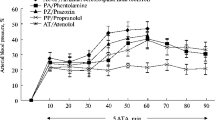Abstract
1. In 5 cats ligthly anesthetized with chloralose-urethane all chemoreceptor response was abolished by cutting the vagosympathetic trunks including depressor nerves and by embolization of the carotid bodies by lycopodium powder. By means of a pressurized bottle attached to the femoral arteries mean arterial pressure was regulated to three different levels (160, 120 and 80 Torr consecutively) and was kept constant at each of these levels. Transients and steady state values of ventilation were recorded during this stepwise change of blood pressure. The effect on ventilation of severing sinus nerves at constant blood pressure was observed.
After severing sinus nerves recording of the effect of blood pressure changes on ventilation was repeated.
2. In this preparation (chemoreceptors denervated, carotid pressoreceptors intact) severing sinus nerves is followed by a diminution of ventilation in the same order of magnitude as described in the preceding papers, even if blood pressure is kept constant.
3. Following stepwise diminution of mean arterial pressure in the chemodenervated cat, ventilation returns to its initial value after a transient increase. This confirms the conclusion of the preceding paper that during steady state no tonic influence of pressoreceptors on ventilation can be observed.
4. The transient increase of ventilation following diminution of blood pressure is less pronounced, but not abolished, after severing the sinus nerves. It is therefore considered to be only partly due to the release of an inhibition by pressoreceptor impulses. The remaining effect must be due to other causes, possibly transient change of cerebral circulation.
5. From this evidence and that from the preceding papers it must be concluded that the steady state decrease of ventilation observed after severing sinus nerves in cats inhaling gas mixtures containing 35 or 99% O2 can not be attributed either to chemoreceptor drive by O2 deficiency or to blood pressure effects on chemo—or pressoreceptors. Effects of CO2 or H+ on chemoreceptors can be excluded as well since in the experiments of this paper all chemoreceptor drive is abolished.
It must therefore be concluded that an unknown respiratory drive is depending upon the integrity of the sinus nerves.
Similar content being viewed by others
Literatur
Brown, A. M., H. N. Duke, and N. Joels: J. Physiol. (Lond.) 165, 266 (1963).
Heymans, C., et J. J. Bouckaert: C. R. Soc. Biol. (Paris) 113, 912 (1933).
—, and E. Neil: Reflexogenic Areas of the Cardio-vascular System. London: Churchill 1958.
Katsaros, B.: Pflügers Arch. ges. Physiol. 282, 157 (1965).
— Pflügers Arch. ges. Physiol. 282, 179 (1965).
— Pflügers Arch. ges. Physiol. 282, 186 (1965).
Lassen, N. A.: Physiol. Rev. 39, 183 (1959).
Schmidt, C. F.: Amer. J. Physiol. 102, 119 (1932).
Author information
Authors and Affiliations
Additional information
Mit 2 Textabbildungen
Mit Unterstützung durch die Deutsche Forschungsgemeinschaft.
Rights and permissions
About this article
Cite this article
Katsaros, B., Loeschcke, H.H. Über die Wirkung der Pressoreceptoren des Carotisgebiets der narkotisierten Katze auf die Atmung nach isolierter Ausschaltung der Chemoreceptoren. Pflügers Archiv 282, 193–199 (1965). https://doi.org/10.1007/BF00362507
Received:
Issue Date:
DOI: https://doi.org/10.1007/BF00362507




